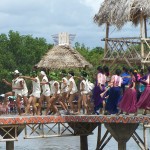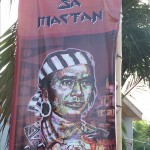
If you read the last posting (Kadaugan, Part IV), you’ll know that I started out at the Kadaugan sa Mactan getting stuck in a poor spot, 3 rows of people behind a fence that separates the audience from the Re-enactment of the Battle of Mactan on the shores of Magellan Bay. And, with a bit of luck, I was able to garner a Press Pass to get the behind the scenes glimpse — or, in this case, on-shore.
And glimpse I did. Here is a taste of what I saw. The performance was choreographed and directed. (I still have to look up the director’s name; it sounded to me like Rogi Palanca.) I’ve divided the performance into scenes or acts, as I interpreted them:
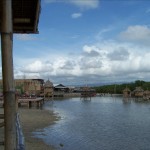
Setting and Venue
9 a.m., Saturday April 27th. Four-hundred-and-eighty-six years after the actual Battle of Mactan. The Bay of Magellan. An overcast day. The sun shined behind the clouds. The bay itself: a small crescent moon of fine sand, green silty waters, and three strands of mangroves.
Pre-show Preparations
Prior to the show, there was singing and prayers beneath the mural of the Battle. The Philippine national flag was raised. There was a a gun salute. The mayor and a congresswoman walked an offering of flowers to the statue of Lapu-lapu which towers over the Bay.
Then, on-shore, re-enactors practice their moves. Men dressed as Lapu-lapu’s warriors twirl 8 foot spears and wield mock-kampilans. Women milled about talking about the daily work dressed in sixteenth century-ish clothes. (For modesty’s sake, both women and men are dressed in modified costumes. Traditional sixteenth century clothing was very scant by today’s standards. And, also, in reality this was a pre-Christian society which did not have the same social prescriptions. Another way to look at it is that they were much more comfortable with their bodies. Also, some Friars viewed Visayan tattoos as art that garmented the skin.) In present day Mactan, the audience buzzed with anticipation.
Music heightens the tension and anticipation. It’s a mix of traditional instruments, percussions, and modern melodies. Very dramatic.
Entrance of mga Artista, the Actors.
The MC announced the arrival of the artista, the two young Filipino movie stars who played Magellan and Lapu-lapu. Cries and gasps rose up whenever the two men moved through the crowd.
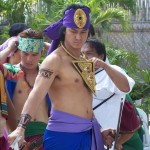
—
Act 1: The Barangay and the Ceremony
Quiet in the barangay. Women in long skirts carry baskets they dip in the sea, perhaps catching fish, perhaps washing. Men wade in the water hunting for fish with spears. A troop of boys dressed in white arrive with dried rushes or switches, dancing. Then, a troop of young women arrive with baskets of leaves and offerings upon their heads. They step in time to drums; bells wind around their ankles. Two women in purple, presumably babaylan (women shamans), enter the dance. Musicians in purple play gorgeous percussions like kolatong, a long bamboo drum.
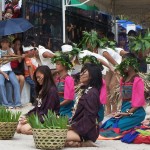
Act 2: The Parlay
Magellan’s priest and two or three of his conquistadors arrive on the shores of the Bay. They parlay with Lapu-lapu’s officer, a large, imposing Mactanyo (still no tilde!). The parlay takes the form of mime and gestures: grand, sweeping motions of the arms. The meaning seems clear. Lapu-lapu’s official waves the priest and conquistadors away, then turns to LL who nods his ascent. Magellan’s priest and conquistadors stay. This time, Lapu-lapu himself motions for them to layas, begone. The party leaves huffily, with dramatic flair.
Act 3: The Battle
Magellan’s conquistadors line up in the sea. Lapu-lapu’s warriors line up on the shore. They stare each other down across the water, then begin to charge at one another. The battle ensues. Swords clash, men fall seemingly dead upon the sand. Women and children run screaming in the backdrop. Canons sound — and the roofs of two nipa houses catch on fire. Meanwhile, Lapu-lapu stands on a far pier, watching the scene. Magellan hangs back, doing the same.
Act 4: Lapu-lapu versus Magellan
Magellan comes forward. Lapu-lapu and he engage each other. They circle and parry, dodge and hit. Lapu-lapu 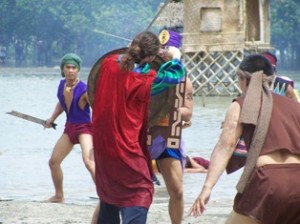 pierces Magellan, near the middle. Magellan is felled. A great cry of triumph issues from the remainder of Lapu-lapu’s men. LL’s men begin to gather the dead. Some six or so men hoist Magellan’s fallen body up and carry it away. Other men gather the dead and carefully place the Spanish soldiers next to each other in the center of shore. Lapu-lapu’s wounded are walked back by other kababayan. This was actually very moving because it seemed that great tenderness was taken with all who fell. I was left with a sense of the loss on both sides and the sadness that is inevitable with battles.
pierces Magellan, near the middle. Magellan is felled. A great cry of triumph issues from the remainder of Lapu-lapu’s men. LL’s men begin to gather the dead. Some six or so men hoist Magellan’s fallen body up and carry it away. Other men gather the dead and carefully place the Spanish soldiers next to each other in the center of shore. Lapu-lapu’s wounded are walked back by other kababayan. This was actually very moving because it seemed that great tenderness was taken with all who fell. I was left with a sense of the loss on both sides and the sadness that is inevitable with battles.
Act 5: Home, Again
Lapu-lapu returns home. A carnival atmosphere. The performance ends with the two dance troops of young men and women returning and all — the datus, the babaylan, the families — dance and parade up onto the pier and back down the shore.
